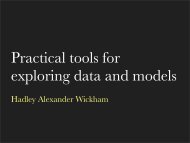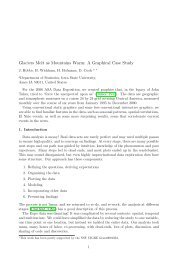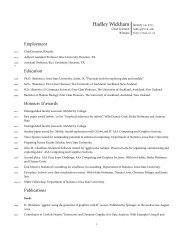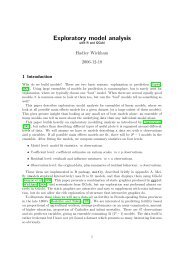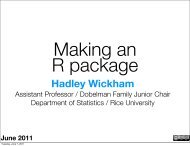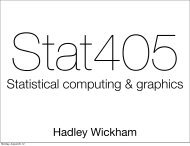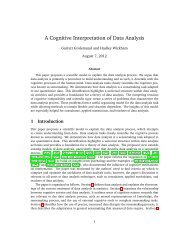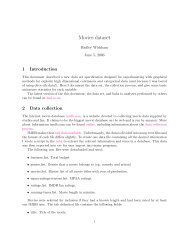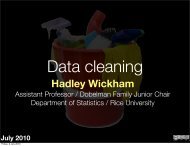Statistical inference for exploratory data analysis ... - Hadley Wickham
Statistical inference for exploratory data analysis ... - Hadley Wickham
Statistical inference for exploratory data analysis ... - Hadley Wickham
You also want an ePaper? Increase the reach of your titles
YUMPU automatically turns print PDFs into web optimized ePapers that Google loves.
<strong>Statistical</strong> <strong>inference</strong> <strong>for</strong> graphics 4377<br />
(vi) Wages <strong>data</strong>: In this example, we study the relationship between wages<br />
and experience in the work<strong>for</strong>ce by race <strong>for</strong> a cohort of male high-school<br />
dropouts. The <strong>data</strong> are taken from Singer & Willett (2003) and contain<br />
longitudinal measurements of wages (adjusted to inflation), years of experience<br />
in the work<strong>for</strong>ce and several covariates, including the subject’s race. A nonparametric<br />
approach <strong>for</strong> exploring the effect of race is to fit a smoother<br />
separately to each racial subgroup in the <strong>data</strong>. If there appears to be a<br />
difference between the curves, how can we assess the magnitude and significance<br />
of the difference? The null scenario is that there is no difference between<br />
the races. To generate null sets, the race label <strong>for</strong> each subject is permuted.<br />
The number of longitudinal measurements <strong>for</strong> each subject varies from one<br />
to 13. Each subject has an id and a race label. These labels are re-assigned<br />
randomly. There will be the same number of subjects in each racial group,<br />
but the number of individual measurements will differ. Nineteen alternative<br />
<strong>data</strong>sets are created. For each <strong>data</strong>set, a loess smooth (Cleveland et al. 1992)<br />
is calculated on each subgroup, and these curves are plotted using different line<br />
types on the same graph, producing 20 plots, including the original (figure 8).<br />
The plots also have the full <strong>data</strong>set shown as points underlying the curves,<br />
with the reasoning being that it is helpful to digest the difference between<br />
curves on the canvas of the variability in the <strong>data</strong>. Here is the question <strong>for</strong><br />
this example.<br />
These 20 plots show smoothed fits of log(wages) to years of<br />
experience in the work<strong>for</strong>ce <strong>for</strong> three demographic subgroups. One<br />
uses real <strong>data</strong>, and the other 19 are produced from null <strong>data</strong>sets,<br />
generated under an assumption that there was no difference between<br />
the subgroups. Which plot is the most different from the others,<br />
paying particular attention to differences in areas where there are<br />
more <strong>data</strong>?<br />
This next part discusses the lineups, revealing the location of the real <strong>data</strong>,<br />
and explaining what we would expect the viewers to see.<br />
(i) Places Rated <strong>data</strong> (figure 3): There is a slight positive association, but<br />
it is not strong. Also, there are two clusters on the right, coastal Cali<strong>for</strong>nia<br />
and the Pacific Northwest. The so-called Climate-Terrain index is really just<br />
a measurement of how extreme versus how moderate the temperatures are,<br />
and there is nothing in the index that measures differences in cloud cover and<br />
precipitation.<br />
Solution: The real <strong>data</strong> are shown in plot 14.<br />
(ii) Tips Data (figure 4 ): Three features are present in the real <strong>data</strong>: skewness,<br />
multi-modality (with peaks at dollar and half-dollar amounts) and three outliers.<br />
Of these the first two are most obviously different from the null sets, and we<br />
would expect these to be reported by the viewer.<br />
Solution: The real <strong>data</strong> are shown in plot 11.<br />
Phil. Trans. R. Soc. A (2009)<br />
Downloaded from<br />
rsta.royalsocietypublishing.org on January 7, 2010



